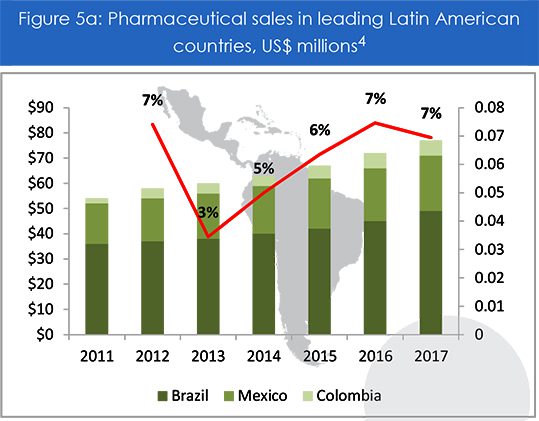The consolidation of pharmacy retailing will generate investment opportunities for medical service providers and retailers
Latin American pharmacy chains are expanding both in terms of geography and breadth of services. In Chile, Colombia and Peru, over 75% of pharmacy retailing is controlled by no more than 3 or 4 large players. As these markets consolidate around a handful of dominant chains, foreign giants are likely to take note and show interest to enter the region.
Modern chains such as Super Farmacias Guadalajara in Mexico or Drogaria Araujo in Brazil have more in common with small supermarkets (or convenience stores) than they do with their roots as single-purpose drugstores. Today, their outlets typically carry a range of products such as dairy, snacks, home care products, personal care items, and non-perishable foods. They also offer convenient services such as cell phone top-ups, bus cards, and payment of utility bills, and even some basic banking and government services.
Latin America’s pharmacy distribution market is experiencing considerable structural changes, as the leading pharmacy chains leverage their buying power, logistics prowess, and brand reputation to consolidate their position in the market. A recent study by Nadro, a Mexican medical wholesaler, revealed that pharmacy chains and supermarkets went from controlling 69% of Mexico’s pharmaceutical sales in 2007 to 88% in 2014. Moreover, as these chains continue to spread to provincial cities and smaller urban areas throughout the countryside, they are going to drive the consolidation of the retail business, impacting not just pharmacies, but retail distribution in general. Right now, the sector’s consolidation and diversification is playing out in three ways:
- Diversification into basic medical services: The expansion of low-cost and, in some cases, free medical checkups and exams onsite within the premises of pharmacy outlets is set to continue. This trend of offering basic medical services within the pharmacy infrastructure is expected to soon also include a range of basic diagnostic services. The dominant chains are well placed to diversify into these adjacent service offerings since they can leverage the proximity to their client base through their expanding network of outlets to provide fast and efficient service at a low cost.
- Vertical integration of the production chain: Pharmacy chains are venturing into the production of private label generic drugs, becoming producers and distributors of pharmaceuticals. In Mexico alone the sale of pharmacy-branded generics is greater than that of other generics brands and is expected to continue growing at over 20% per year.

- Consolidation of the distribution channels: The worldwide trend of medical distributors and pharmacy retailers forging tighter bonds is beginning to take place in Latin America as well. Some of the largest medicine distributors work exclusively with one large pharmacy chain: in Chile Sofocar and Farmacias Cruz Verde have struck an alliance; in Peru, Quimica Suiza and Boticas BTL; in Brazil Profarma and CSB Drogarias; in Mexico Farmacias Del Ahorro and Fármacos Nacionales.
To date CVS and Alliance Boots are among the few international companies that have entered the region through the acquisition of established local players. CVS acquired Drogaria Onofre in Brazil, whereas Alliance Boots purchased Farmacias Benavides in Mexico and FASA in Chile. As the pharmacy retail sector consolidates, however, local chains that are dominant in their markets will become ever more appealing to foreign investors who have thus far remained relatively quiet in the region.





